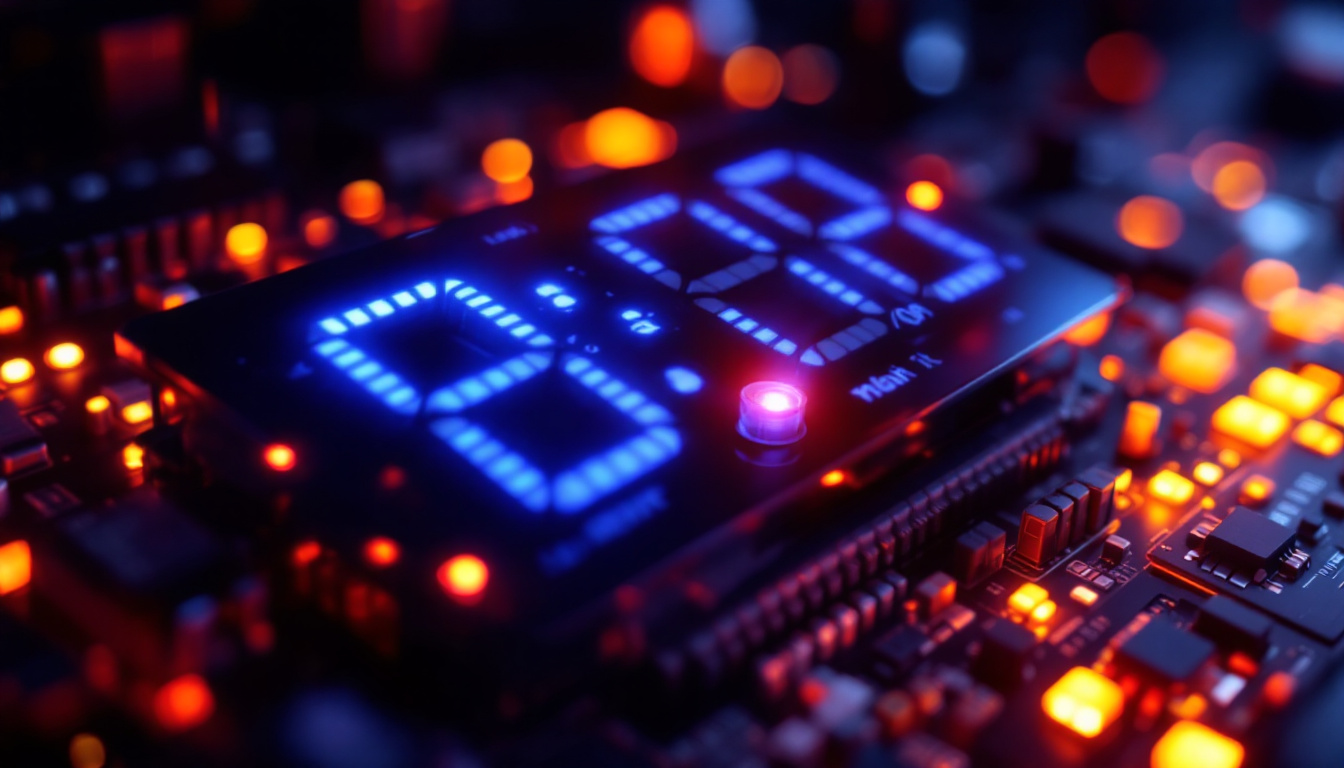In the realm of modern technology, LED displays have become ubiquitous, especially in the world of counters. Among the various types of counters, DVA counters stand out for their unique functionality and versatility. This article delves into the intricacies of DVA counters, exploring their design, operation, and applications, while illuminating the role of LED displays in enhancing their usability.
Understanding DVA Counters
DVA counters, or Digital Visual Analyzers, are sophisticated devices designed to count and display numerical data with precision. They are often employed in environments where accurate measurement and monitoring are crucial, such as manufacturing, event management, and scientific research. The primary function of these counters is to provide real-time data, which is essential for decision-making processes. In addition to their counting capabilities, DVA counters can also be integrated with software systems that allow for advanced data analysis and reporting. This integration can enhance operational efficiency by providing insights that lead to improved processes and outcomes.
Key Features of DVA Counters
One of the defining features of DVA counters is their ability to display data in a clear and concise manner. The integration of LED displays significantly enhances readability, allowing users to quickly interpret information. Additionally, these counters often come equipped with various functionalities, such as programmable settings, multiple counting modes, and connectivity options for data logging and analysis. Many models also feature customizable alerts or notifications, which can be set to trigger based on specific thresholds, ensuring that users are immediately informed of significant changes in data trends.
Another notable feature is their durability. DVA counters are typically designed to withstand harsh environments, making them suitable for industrial applications. Their robust construction ensures longevity, which is a critical factor for organizations looking to invest in reliable counting solutions. Furthermore, many DVA counters are designed with user-friendly interfaces, allowing even those with minimal technical expertise to operate them effectively. This ease of use can lead to quicker adoption and training times, ultimately benefiting the overall productivity of the workplace.
How DVA Counters Work
The operation of DVA counters revolves around a simple yet effective mechanism. They utilize sensors to detect and count events, such as the passing of objects or the occurrence of specific actions. Once an event is detected, the counter processes this information and updates the display accordingly. The sensors used can vary, including infrared, laser, or mechanical types, each suited for different counting scenarios. This versatility allows DVA counters to be tailored to specific applications, whether it’s counting people entering a venue or monitoring the flow of materials on a production line.
LED displays play a pivotal role in this process. They provide a visual representation of the counted data, often using bright and clear digits that are easily visible from a distance. The technology behind LED displays ensures that they consume less power while delivering high brightness levels, making them ideal for both indoor and outdoor applications. Additionally, many DVA counters incorporate features such as backlighting or adjustable brightness settings, which further enhance visibility in varying lighting conditions. This adaptability is particularly beneficial in environments where lighting can fluctuate, ensuring that users can always access accurate data without strain.
The Role of LED Displays in DVA Counters
LED displays are more than just a visual aid; they are integral to the functionality of DVA counters. Their design and technology contribute significantly to the overall performance and user experience of these devices.
Advantages of LED Technology
One of the primary advantages of LED technology is its energy efficiency. Compared to traditional display technologies, LEDs consume significantly less power, which is particularly beneficial for devices that are in constant use. This efficiency not only reduces operational costs but also extends the lifespan of the counter. Furthermore, the low heat output of LED displays means that they can operate in a wider range of environments without the risk of overheating, making them ideal for industrial applications where temperature fluctuations are common.
Additionally, LED displays offer superior visibility. They can be seen clearly in various lighting conditions, making them suitable for both bright and dim environments. This feature is crucial for applications where quick data interpretation is necessary, such as in busy manufacturing floors or during events where multiple counters may be in use simultaneously. The high contrast and vibrant colors of LED displays further enhance readability, allowing operators to quickly assess critical information at a glance, thereby improving decision-making speed and accuracy.
Customization and Flexibility
Another significant advantage of LED displays in DVA counters is their customization potential. Users can often choose from different display formats, colors, and sizes to suit their specific needs. This flexibility allows organizations to tailor their counters to fit seamlessly into their existing systems and workflows. For instance, a company may opt for larger displays in high-traffic areas, ensuring that information is easily accessible to all personnel, while smaller, more discreet displays can be utilized in less frequented locations.
Moreover, many DVA counters with LED displays come with programmable features that enable users to set thresholds, alarms, and other parameters. This level of customization enhances the functionality of the counter, making it a versatile tool for various applications. Users can program specific alerts for different scenarios, such as notifying operators when production quotas are met or when maintenance is required. This proactive approach not only streamlines operations but also helps in maintaining safety standards, as timely alerts can prevent potential hazards in fast-paced environments.
Applications of DVA Counters
DVA counters find applications across a wide range of industries, each benefiting from the precise counting and data display capabilities they offer. Understanding these applications can provide insights into the versatility and importance of these devices in modern operations.
Industrial Applications
In industrial settings, DVA counters are invaluable for monitoring production lines. They can count items as they move along a conveyor belt, ensuring that production targets are met and that quality control measures are in place. The real-time data provided by these counters allows managers to make informed decisions quickly, optimizing efficiency and productivity.
Furthermore, DVA counters can be integrated into automated systems, enhancing their functionality. For example, they can trigger alarms or notifications when production thresholds are reached, ensuring that operations run smoothly without manual intervention.
Event Management
In the realm of event management, DVA counters are used to monitor attendance and track participation in various activities. Whether it’s a concert, conference, or sporting event, these counters provide accurate headcounts, which are essential for safety and logistical planning.
LED displays in this context serve to provide real-time updates to event organizers and attendees alike. Displaying the current attendance figures can help manage crowd control and ensure that venues do not exceed their capacity limits, thus enhancing safety and compliance with regulations.
Choosing the Right DVA Counter
When selecting a DVA counter, several factors should be considered to ensure that the device meets the specific needs of the application. Understanding these factors can help organizations make informed decisions that align with their operational requirements.
Functionality and Features
First and foremost, it is essential to evaluate the functionality and features of the DVA counter. Different models may offer varying capabilities, such as multiple counting modes, data logging, and connectivity options. Organizations should assess their specific needs and choose a counter that provides the necessary features to enhance their operations.
Additionally, consider the ease of use. A user-friendly interface can significantly improve the efficiency of operations, allowing personnel to focus on their tasks rather than struggling with complex controls.
Durability and Reliability
Durability is another critical factor, especially for counters used in industrial environments. Look for models that are built to withstand harsh conditions, including exposure to dust, moisture, and temperature fluctuations. A reliable DVA counter will minimize downtime and ensure consistent performance over time.
Maintenance and Care for DVA Counters
Proper maintenance and care are vital to ensure the longevity and optimal performance of DVA counters. Regular maintenance can prevent malfunctions and extend the lifespan of the device.
Regular Cleaning
One of the simplest yet most effective maintenance practices is regular cleaning. Dust and debris can accumulate on the LED display and sensors, potentially affecting their performance. Using a soft, dry cloth to clean the display and surrounding areas can help maintain clarity and functionality.
Additionally, it is essential to inspect the device for any signs of wear or damage. Addressing issues early can prevent more significant problems down the line and ensure that the counter continues to operate effectively.
Software Updates
For DVA counters that feature programmable settings or connectivity options, keeping the software up to date is crucial. Manufacturers often release updates that can enhance functionality, improve performance, or address security vulnerabilities. Regularly checking for and applying these updates can ensure that the device operates at its best.
Conclusion
DVA counters equipped with LED displays represent a significant advancement in counting technology. Their ability to provide accurate, real-time data in a user-friendly format makes them indispensable in various industries. From industrial applications to event management, the versatility of DVA counters is evident.
As technology continues to evolve, the integration of advanced features and enhancements will likely further improve the functionality of these counters. Organizations that invest in DVA counters can expect to see increased efficiency, better data management, and ultimately, enhanced decision-making capabilities.
In summary, understanding the intricacies of DVA counters and the role of LED displays is essential for leveraging their full potential. By choosing the right device and implementing proper maintenance practices, organizations can ensure they are equipped with a reliable tool that meets their counting and data display needs.
Enhance Your Counting Technology with LumenMatrix
Ready to take your counting and data display capabilities to the next level? LumenMatrix is at the forefront of LED display innovation, offering a wide array of solutions tailored to your needs. From Indoor and Outdoor LED Wall Displays to specialized options like Vehicle, Sports, and Floor LED Displays, our products are designed to deliver unparalleled clarity and performance. Experience the transformative power of our Custom, All-in-One, and Transparent LED Displays and see how we can help you make a lasting impression. Check out LumenMatrix LED Display Solutions today and revolutionize the way you communicate visually.































